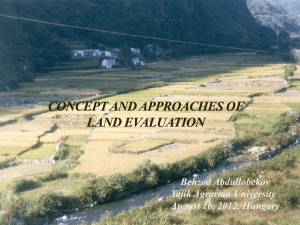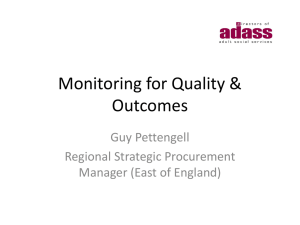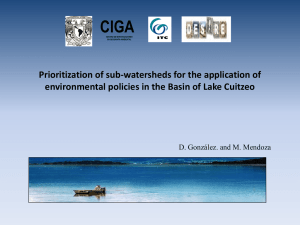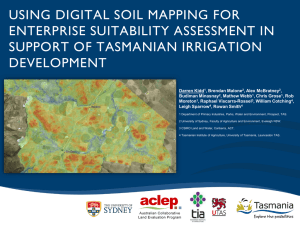Terrain Characteristics and their impact on Landuse of the Igo River
advertisement
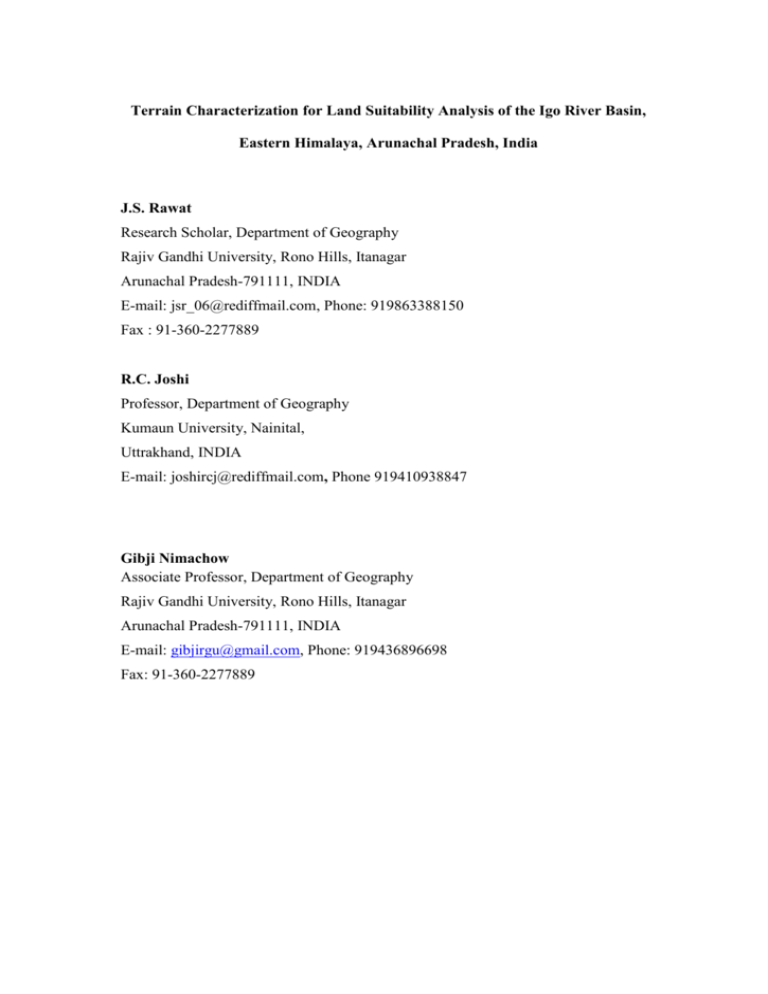
Terrain Characterization for Land Suitability Analysis of the Igo River Basin, Eastern Himalaya, Arunachal Pradesh, India J.S. Rawat Research Scholar, Department of Geography Rajiv Gandhi University, Rono Hills, Itanagar Arunachal Pradesh-791111, INDIA E-mail: jsr_06@rediffmail.com, Phone: 919863388150 Fax : 91-360-2277889 R.C. Joshi Professor, Department of Geography Kumaun University, Nainital, Uttrakhand, INDIA E-mail: joshircj@rediffmail.com, Phone 919410938847 Gibji Nimachow Associate Professor, Department of Geography Rajiv Gandhi University, Rono Hills, Itanagar Arunachal Pradesh-791111, INDIA E-mail: gibjirgu@gmail.com, Phone: 919436896698 Fax: 91-360-2277889 Terrain Characterization for Land Suitability Analysis of the Igo River Basin, Eastern Himalaya, Arunachal Pradesh, India Abstract Terrain characterisation is a process through which fractal nature of terrain and its biophysical processes are quantified or attributed into thematic layers. The synthesis of thematic layers results different terrain units or land suitability class which is important for planning, land-use and land management. This paper attempts to carry out terrain analysis and land suitability classification of the Igo River basin, West Siang District, Arunachal Pradesh (India). The terrain characteristics are generated into physical, morphological, hydrological and other remote sensing based thematic layers. The Spatial Multi-Criteria Evaluation (SMCE) module is used to standardize and weigh the data. The final output, a composite index map, is sliced into three suitability categories as highly suitable (S1), moderately suitable (S2) and marginally suitable (S3). S1 and S2 occupy 96.50 km2 (31.45%) and 56.34 km2 (18.36%) area respectively while S3 constitutes 154 km2 area forming 50.19% of the study area. The terrain characterization based land suitability classification using remote sensing, Geographical Information System (GIS) and SMCE is very significant in the mountainous and inaccessible area like Arunachal Pradesh. Keywords DEM, Terrain Analysis, Land Suitability, SMCE, Remote Sensing, Arunachal Pradesh 1. Introduction Terrain consists of the physiography, lithology, morphometry, soil geography and to some extends land cover (Meijerink, 1988). The abiotic attributes (relief, geological or geomorphological processes, lithology, soil, etc) and hydrological condition complemented by vegetation/land-cover types characterises the terrain, (Van Zuidam, 1985). Terrain analysis for land suitability is a process through which fractal nature of terrains along with various biophysical processes are quantified or attributed into thematic layers. These thematic layers containing information of local land system are then synthesized through an overlay function in Geographical Information System (GIS) which helps in delineating different suitability classes of terrain. The resultant terrain units presented in the form of map and report are meaningful to a local user (Ceballos-Silva and Lopez-Blanco 2003a). Quantification of terrain for land suitability necessitates compilation of data on requirements of landuse/landcover, determination of biophysical potentials and identification of more or less homogeneous land mapping units (Kilic, et al., 2005). Thus, land suitability analysis is an inventory on land resources in terms of limitations and potentials which is useful in land management and planning. The process of land suitability classification is the evaluation and grouping of specific areas of land in terms of their suitability for a defined use (Chen et al., 2010; Bhagat et al., 2009). The objective of land evaluation is to predict inherent capacity of a land unit to support a specific landuse for long period of time without deteriorating, in order to minimize the socio-economic and environmental costs (de la Rosa 2000). Since the dawn of agriculture and industrial revolution, the pattern of human development rate and consumption of world resource has brought unprecedented change on earth. In many areas the earth’s surface is bearing scars of thousand years of human interferences. Moreover, about three- quarters of the land surface is already unsuitable for crop cultivation, suffering from severe constraints of being too cold (13%), too dry (27%), too steep (12%) or having poor soil (40%) (Bhagat et al., 2009). The global concern about food security, quality of future life and growing awareness of environmental degradation is posing serious question to the achievements of science (Lashkar, 2003). Evaluation of land resource, their management and planning, therefore, has become an important component of sustainability throughout the world (Hall et al., 2000). The concept ‘sustainable development’ popularized by World Commission on Environment and Development (1987) and Earth Summits (1992 and 1997) is interpreted in several ways by various disciplines. Application of this sustainability principle in land resource management underscores both ecological suitability and economical viability (Van Lier, 1994). The Food and Agricultural Organization (1976) proposes an approach for land suitability evaluation in terms of suitability ratings from highly suitable to not suitable based on the suitability of land characteristics. Hopkins (1977) presents a comparative evaluation of alternative methods of assessing land suitability. Anderson (1987) surveys different methods of land potentiality/suitability analysis ranging in degrees of computational and analytical sophistication. Steiner (1983, 1987) reviews land evaluation and site assessment (LESA) using USDA-recommended standards. According to FAO (1993) Land suitability evaluation and agricultural land use planning is very necessary and is the basic information for right decision making afterward (Van Chuong 2008). Suitability analysis generally involves determining an appropriate approach to combine these factors. The principal problem of suitability analysis is to measure both the individual and cumulative effects of the different factors. Some approaches of combining the factors are composite rating including weighted composite rating (Anderson 1987), weighted factor method (Hopkins 1977), various multi-criteria approaches such as compromise programming (Pereira and Duckstein 1993), Prioritized Land Use Suitability (Xiang and Whitley 1994), modified weighted factor (Diamond and Wright 1988), etc. Martin and Saha (2001), Boonyanuphap et al., (2004), Kilic et al., (2005), Chen et al., (2010), Pirbalouti and Golparvar (2008), Bhagat et al., (2009), etc., uses Remote Sensing and GIS for land suitability classification. On the other hand, Prakash (2003), Keshavarzi et al., (2010), Hartati and Sitanggang (2010), etc., employs fuzzy technique assess land suitability for different crops while Pereira and Duckstein (1993), Lashkar (2003), CeballosSilva and Lopez-Blanco (2003a), Geneletti (2007), Van Chuong (2008), etc makes use of Multi-criteria Spatial Evaluation in GIS. Although FAO (1976 and 1985) proposes land suitability analysis mainly for crops based on factors like crop requirement and limitations, management, land development conservation and socio-economic conditions. The present study focuses overall land suitability classification on terrain parameters for Igo river basin in Arunachal Pradesh (India) using GIS and Spatial Multi-Criteria Evaluation (SMCE) system. Since various morphological, hydrological and physical terrain conditions sets different degree of limitation or potentialities on a parcel of land for its general use, it is assumed that these terrain characters by and large helps in determining the most suitable and sustainable use of the land particularly in the hilly area like Arunachal Pradesh. 2. Study Area For this study the Igo River basin in the West Siang District of Arunachal Pradesh is delineated using Survey of India Topographical Maps (Figure 1). Bounded by 27o 46’ 36” N to 27o 57’ 17”N latitude and 94o 35’ 35” E to 94o 54’ 39” E longitude, the Igo basin covers about 306 km2 area. The southern part of the study area comprises Kimin and Dafla formations (loose conglomerate, shale and sandstone) of Outer Himalaya corresponding Miocene to Pleistocene. A tectonic belt i.e. Main Boundary Thrust (MBT) passes through the middle of the study area delineating the Lesser Himalaya from the Outer Himalaya. The maximum area contains rocks of the Lesser Himalaya belonging to Paleoproterozoic and Lower Permian periods. The Dolimestone of the Bomdila group occurs in the north-eastern part, Chilliepam formation of the Lower Gondwana group is found in the western tip while the remaining parts of the Lesser Himalaya consist of Miri formation. Physiographically, the undulating hills of low to moderate altitude forms maximum parts of the area with scattered patches of plain lands along river corridors. On an average, the area receives 2370 mm annual rainfall with mean minimum temperature between 7.9º C in the month of January to 22.4º C in July and the mean maximum temperature fluctuating from 16.4º C to 28.5º C in the January and August respectively. The sub-tropical evergreen, tropical evergreen, tropical semi-evergreen and moist deciduous forests form the natural vegetation in study area. There are 15 settlements in the study area, which are mainly villages. They are Garu, Garu Camp, Rilu, Tapo, Igo Camp, New Dari, Old Dari, Dali, Dali Hydel, Dali Camp, Ichi, Chisi, Padi and Rimi. The distant villages, like Tapo, New Dari, Old Dari and Ichi, are connected by village road or foot-path tracks. Other settlements are found along the road which cut across study area. The inhabitants being tribal communities predominantly practice traditional slash-and-burn method of cultivation known as jhum cultivation along the hillslopes and settled wet rice cultivation in the plains of river corridors. 3. Data use and Methodology The litho-structural characteristics are carried out following Kumar (1997), which is compared with satellite images and cross checked during field survey. Since there is no meteorological station in the study area, the rainfall data in the surrounding stations are used for interpolation. Similarly, physiography and soil information are digitized from the Natural Resource Atlas of Arunachal Pradesh. Digital Elevation Model (DEM) is created by interpolating digitized contours combined with spot heights of Survey of India (SOI) Topographical Maps. ITC methodology of Hengl et al., (2003) is followed to optimize DEM and to remove the artifacts. Filtered DEM with a pixel size of 10 m is then used for the extraction of morphological and hydrological parameters. Besides, basin morphometry and drainage pattern analysis are carried out with the help of drainage vector layer digitized from SOI Maps. The IRS 1D multi-spectral LISS III 8 bits data of path/row 113/052 on 16th November 2002 (Table 2) is used for preparing landcover raster layer. The Normalized Difference Vegetation Index (NDVI) and different colour composites are obtained from Band2, Band3 and Band4 of LISS III. NDVI is used for masking vegetative and non-vegetative areas. The vegetative layer is converted into fraction vegetation cover in percentage (Ve) following relationship of the Zhang et al., (2002): Ve = 93.07466*NDVI + 8.79815. On the basis of Ve (canopy density) four classes of forest are obtained using the classification scheme of Forest Survey of India. These are Dense Forest (density > 70%), Moderately Dense Forest (40 to 70%), Open Forest (10 to 40%) and Scrub Forest (density < 10%). The non-forest layer is treated separately to classify into settlement area, road, water bodies, and cultivated area, using False Color Composite (FCC), Normalized Difference Water Index and Hybrid Color Composite (HCC). HCC is PCA1 (First Principal Component of Band 1, Band 2, Band 3 and Band 4 of LISS III), Ratio1 (Band 3/ Band 2 of IRS LISS III ) and Ratio2 (Band 3/Band 1) passed through red, green and blue respectively. With adequate ground truthing, at every stage, the area is classified into different landuse/landcover categories with an overall accuracy of 73.81%. The lineament map is derived using LIN algorithm in the PCI Geomatica and lineament density is calculated in raster format. Landslide Hazard Zonation is carried out following landslide index method of ITC, Netherlands. The factors used are slope gradient, slope length, slope aspect, slope type, generic landforms, physiography, geology, lineament distance, road distance, drainage distance, altitudinal zone and landuse/landcover. The soil loss intensity is obtained using Universal Soil Loss Equation (USLE) developed by United States Department of Agriculture (USDA), Wischmeier and Smith, (1978). Since DEM is prepared with a pixel size of 10 m and all its derivates by default inherits this property, all other raster layers are resampled in 10 m pixel size for raster analysis. Finally, terrain analysis is performed using SMCE Module. The whole raster data cube of the above mentioned terrain characters are submitted to SMCE module in three sub-sets i.e. morphological, hydrological and other. They are further grouped into constrains or factors and cost or benefits, standardize and weighed in a criteria tree (Figure 2). The final output is a composite index map which is sliced into three suitability categories as highly suitable (S1), moderately suitable (S2) and marginally suitable (S3). 4. Result and Discussion 4.1. Terrain Characteristics The result of the terrain characterization, as presented in Table 3, shows that slope comprises more than 87% of the area, only about 3% is plain and rest are ridges, peak, pits, etc. Physiographically, moderately dissected steep slope moderate erosion constitutes 79.38% of the area. On the basis of texture the main soil types are fine loamy, coarse loamy, loamy skeletal, clayey, fine loamy mixed. Altitude ranges from 202 to 1780 m with mean height is 798.6. The maximum occurring elevation is 380 m. The relative relief in 100 x 100 m dimension ranges from 0 to 230.80 m with an average of 59.32 and maximum experienced relief of 60 m. Although, range of slope magnitude varies from 0 to 572.30%, maximum slope is found in the lower values with mean 54.31% and mode 66.50%. The standard deviation of 30.74 and coefficient of variation 56.60 suggests wide variation in slope. The mean value of slope aspect represents southern declination, while modal value indicates the northern aspect. The values of shape complexity index shows that maximum areas have highly complex to complex terrain which together constitutes about 85% area. The analysis of spatial arrangement of drainage revealed dendritic pattern as most common drainage pattern associated with Lower Gondwana rocks which indicate homogeneous lithologies and uniform resistance. The sub-parallel trellis is observed along the MBT and Siwalik group resembling simple folds characterized by parallel anticlinal ridges and synclinal valleys. The master streams have frequent right-angled bends along fault lines and tributaries maintain parallelism to MBT displaying structural control. The rectangular pattern occurs in the northern dolomite areas which are likely to have faults and joints controlling the courses of streams with wide spacing and perpendicular bends. Chisi River flowing between parallel ridges displays a rib like pattern. The straight lateral streams are due to slope factor and short distance between ridges to longitudinal valley stream. Besides, there are several examples of streams resembling radial patterns influenced by isolated hills and peaks along the ridges. Both stream numbers and stream lengths in Igo river basin and its sub-basins maintain law of inverse geometric series with stream orders. The bifurcation ratio (Rb) up to 3rd/4th order of all basins is concentrated towards higher values showing poor integration between streams. Beyond these orders the ratio shows more stream integration with low values. However, the weighted mean Rb of Igo basin is 3.86 ranging between 2.76 to 5.17 in the sub-basins. The stream length ratio of Igo basin and its tributary basins vary slightly along the successive orders because of the varying topography and slope. The relief ratio, as shown in Table 4, is high in the subbasins like Rimi, Sikki, Siggi and Sike which lie along faults and thrusts showing high intensity of degradational processes. The elongation ratio suggests strong relief and steep slopes which ranges from 0.5 to 0.8. Similarly, the circulatory ratio indicates youthful stage of dissection in Igo basin and sub-basins. Only four sub-basins (Kudo, Dachi, Tumru and Rimi) have slightly circular basins indicating a matured stage of dissection. The drainage density in 100 m grids (0.01 km2) ranges from 0 to 891.4 m with an average density of 88.92 m and standard deviation 150.29. Value 0 indicates no stream which constitutes 28% area followed by moderate stream density covering 25% (Table 2). Very high density with stream length more than 400 m covers only 2.92% area. The flow length, a measure of distance travelled by runoff and transported soil mass along the slope, ranges from 0 to 1582 m in Igo River Basin. More than a quarter (27.93%) experiences the overland flow length varying in between 100 to 200 m followed by 21% area having 200 to 300 m and 18% area experiencing 300 to 500 m overland flow. The Compound Topographic Index (CTI), a measure of runoff concentration or moisture distribution, ranges from 1 to 14 in the study area. However, 64% area falls under 4 to 6 value categorized as moderate CTI. Only 5% area experiences more than 8 CTI value. The Sediment Transport Index (STI) expressing relative effects of topography on soil loss ranges from 0 to 481 with an average of 23.54 and standard deviation of 22.50. About 61% of the study area experiences moderate and high STI value. Among the landcover categories, settlements occupy 0.27% and road cover 0.19% areas. The wet rice fields concentrated along valley bottom forms 1.62% area where as shifting cultivations along the slope or ridges constitute 2.90% of the study area. The maximum area of the basin is found under the dense forest spreading over 42.23%, moderately dense forest covers 22.10%, open forest 27.32% and scrub forest constitutes 1.99% area. The lineament density under 250 m grids (0.063 km2) varies from 0 to 790.9 m. About 50% of area falls under no lineaments category with lineament density 0. The maximum area falls under high lineament density varying from 200 to 400 m which comprises 26.50%. About 11% of the area has moderate lineament density ranging from 100 to 200 m. Due to the undulating topography and loose lithology, Igo basin experiences frequent landslides. About 30% area falls under each moderately low and moderate landslide category followed by high landslide category covering 22% area. The very high and extremely high landslide together constitutes about 10% of the area. Similarly, very high annual soil loss occurs in Igo river basin which ranges from 0.01 to above 770 ton ha-1 year-1. Although maximum area falls under very slight soil loss of below 1 ton ha-1 year-1 followed by 24% area under moderate soil loss of 20 to 50 ton ha-1 year-1, severe to extremely severe together constituting 15% area experience soil loss to the tune of 100 to 200 ton ha-1 year-1 and above. 4.2. Land Suitability Classification The synthesis of physical, morphological, hydrological and other remote sensing based parameters through composite index of SMCE results into three suitability classes (Figure 3). These suitability classes represent the three suitability degrees of FAO (1976). Accordingly, the classes are named as highly suitable (S1), moderately suitable (S2) and marginally suitable (S3). The composite index ranging from 0.576 to 0.86 are grouped under S1 category (Table 5). It covers 96.50 km2 area forming 31.45% of the basin. The composite index varying from 0.29 to 0.57 has been assigned S2 class which occupies 56.34 km2 area forming 18.36% of the total. The areas having composite index from 0 to 0.29 are named as S3. S3 covers almost half of the study area accounting 154 km2. This is mainly because of the rugged nature of topography with high gradient of slopes. Land suitability classification carried out by Ceballos-Silva and López-Blanco (2003a & b); Van Chuong (2008); Pirbalouti and Golparvar (2008); Martin and Saha (2009); Bhagat et al., (2009); Keshavarzi (2010) focuses on the crop requirement using climate, soil properties and relief or slope parameters. On the other hand Chen et al., (2010) conducts biophysical evaluation of land suitability for irrigation intensification or extensification on five criteria like slope, soil texture, depth to water table, electrical conductivity of ground water and hydraulic conductivity of soil. Similar to the result of Chen et al., (2010), S1 in the present study is mainly concentrated in the valley plains and S3 in extremely steep slope and rugged topography. The valley plains being good in soil depth, well drained, and conveniently irrigated are used for paddy cultivation. S2 mainly occurs between S1 and S3 in patches and sometimes parallel to other two categories. The degree and magnitude of constraints in this category is relatively higher than S1 and less severe than S3. However, in S3 there are severe limitations and constraints on the land for its sustainable application to any type of use. Land suitability indices reflect inherent capacity of the land (Braimoh et al., 2004). In well applicable land suitability approach subtle differences in land characteristic is of the major interests (Keshavarzi et al., 2010). Further, the multiple integration options in GIS are of immense use for data integration and overlay analysis to obtain better, faster and cost-effective assessment for judicious utilization and allocation of natural resources (Chen et al., 2010; Martin and Saha 2009). S1 is characterized by gentle to very gentle slope, very low to low relief, least severe soil loss and landslide hazards, etc. The areas with gentle slope are found to be ideal for shifting cultivation. In Dali, Chisi and Padi, people grow fruits, palm tree (Livistona jenkinsiana Griff - locally called Toko) and bamboo along the gentle to moderate slope areas in S1. Plain and gently sloping areas along the ridges are used for growing chilly as cash crop through shifting cultivation. However, in the higher reaches and far off areas such gentle slope ridges are still covered by dense forest. In S2, slope is moderately steep to steep, relief is moderate, and the hazards are less severe. Although some areas are already brought under the human use (mainly shifting cultivation), the major chunk is still under forest. However, the density of the forest cover in many cases is not up to the level to ensure protection of soil loss hazards especially in open and scrub forests. S3 is constrained by the combination of unfavourable factors like very steep to extremely steep slope, high to very high relief, high soil loss due to shifting cultivation, landslide hazard controlled by structure or often triggered by anthropogenic activities and areas covered by water bodies (river bed including flood plains). Although some pockets are under dense forest cover; but to bring these areas under particular land use is cost prohibitive. Due to the high cost and hard nature of terrain the degree of human interference in this category is already very low. However, some portions have their genesis to anthropogenic causes especially those patches highly affected by severe soil loss and landslide hazards. The magnitude of the soil loss is very high ranging from 50 to above 200 ton ha-1 year-1. SMCE of climate, soil and relief environment-components is useful to delineate suitable areas for production and the SMCE–GIS combination has potentiality to provide a rational, objective and non-biased approach for making decisions in agricultural applications (Ceballos-Silva and Lopez-Blanco 2003b). Terrain characterisation (Table 3) shows that in Igo basin about 5% of the total area is under the effective use for settlement and agriculture while another 29% area is under open and scrub forests which are cumulative result of recurrent shifting cultivation and extraction of forest product. The result of present land suitability, on the other hand, shows about 50% area under highly suitable and moderately suitable category. This shows the potentiality of extension for different landuse practices. The S1 in the valley plain can be retained for wet rice cultivation with some improved support practices (Chen et al., 2010). However, in study area maximum area under cultivation is used for shifting cultivation which is associated with high rates of soil loss and sometime landslides. The traditional protection methods in jhum are not adequate to prevent top soil erosion. Unfortunately, concentration of the most erosive rain also coincides with early stage of jhumming. On the other hand, jhum has become rather a cultural choice and lifestyle than merely an agricultural practice for its being deeply rooted in tradition, belief, taste, festivals, legends and myths of the tribal communities (Rawat et al., 2010). It is due to this fact any alternative to shifting cultivation is not acceptable to tribal people in Arunachal Pradesh. Therefore, the need of the hour is to improve jhum on scientific basis with more conservation measures for protection of environment and land management. The extension of silvi pastoral system, sericulture cum agro-forestry, and other methods of multi-storied agro-forestry could serve as an environmentally suitable and economically viable practice in the hilly parts of the study area. 6. Conclusion The land suitability classification based on terrain parameters like morphological, hydrological and other physical parameters gives satisfactory result. Each land suitability category is expressed in terms of the degree of limitation and potentials of selected parameters for its sustainable application. GIS based terrain characterization and its application for land suitability assessment is a new approach which may serve as effective tool for land use planners and land management bodies. There has been very scanty works carried out in Arunachal Pradesh and data for many variables are not available. Thus land suitability classification on terrain characters using GIS and remote sensing would be very effective and useful way of land assessment for the mountainous and inaccessible area like Arunachal Pradesh. The SMCE allows integration and synthesis of large numbers of terrain data and provides land suitability classes as per the desired criteria and goal. In comparison to the conventional GISbased analysis, SMCE is more flexible, easy and efficient for handling large size data cube in different sets and sub-sets. Since the jhum is predominant practice in Arunachal Pradesh accompanied by other different method of cultivation, this study demonstrates the overall land suitability classification. This approach can be extended to a crop based or cultivation-type based suitability assessment and for other land use planning. Determination of the parameters and their weighing is vital because they directly influence the evaluation result. Hence, adequate precision is required to be accorded while selecting parameters, standardizing and weighing parameters for the defined goal. 7. Acknowledgment This paper is a part of the Ph D thesis of Mr. J.S. Rawat under the Supervision of Prof. R.C. Joshi, DEAN, Environmental Sciences, Rajiv Gandhi University, Rono Hills, Itanagar, Arunachal Pradesh (India). Authors are thankful to Department of Science & Technology, Ministry of Science and Technology; Government of India for providing Senor Research Fellowship to Mr. Rawat in a Research Project entitled “An Assessment of Soil Loss using GIS” which facilitated the accomplishment of Rawat’s Ph D work. 8. Reference Anderson, L.T. (1987). Seven methods for calculating land capability/suitability, Planning Advisory Service (PAS) Report No. 402. Chicago, USA: American Planning Association. Bhagat R.M., Singh S., Sood C., Rana R.S., Kalia V., Pradhan S., Immerzeel W. and Shrestha B. (2009). Land Suitability Analysis for Cereal Production in Himachal Pradesh (India) using Geographical Information System. Journal of Indian Society of Remote Sensing, 37, 233-240. Boonyanuphap J., Wattanachaiyingcharoen D. and Sakurai K. (2004). GIS-based land suitability assessment for Musa (ABB group) plantation. Journal of Applied Horticulture, 6(1), 3-10. Braimoh A. K. and Stein A. (2004). Land evaluation for Maize based on Fuzzy set and interpolation. Journal of Environmental Management, 33(2), 226–238. Ceballos-Silva A. and López-Blanco J. (2003a). Evaluating biophysical variables to identify suitable areas for oat in central Mexico: A multi-criteria and GIS approach. Agricuture Ecosystem and Environment Journal, 95, 371-377. Ceballos-Silva A. and Lopez-Blanco J. (2003b). Delineation of suitable areas for crops using a Multi-Criteria Evaluation approach and land use/cover mapping: a case study in Central Mexico. Agricultural Systems, 77, 117–136 Chen Y., Khan S. and Paydar Z. (2010). To Retire or Expand? A fuzzy GIS-based spatial multi-criteria evaluation framework for irrigated agriculture. Irrigation and Drainage, 59(2), 174-188. de la Rosa D. (2000). MicroLEIS 2000: Conceptual Framework, Instituto de Recursos Naturalesy Agrobiologia, CSIC, Avda. Spain: Reina Mercedes. Diamond J.T. and Wright J. (1988). Design of an integrated spatial information system for multi-objective land use planning. Environment and Planning B: Planning and Design, 15, 205–214. FAO (1976). A Frame Work for Land Evaluation, Soils Bulletin No. 32. Rome: UNOFAO. FAO (1985). Guidelines: Land Evalustion for Irrigated Agriculture, Soil Bulletin No. 55. Rome: UNO-FAO. Forest Survey of India (2008). Ministry of Environment & Forest, Government of Arunachal Pradesh, http://www.fsi.nic.in/, accessed as on 20th March 2008. Geneletti D. (2007). An approach based on spatial multicriteria analysis to map the nature conservation value of agricultural land. Journal of Environmental Management, 83, 228–235. Hall M., Hall C.A.S. and Taylor M. (2000). Geographical Modelling – the synthesis of a GIS and simulation Modelling. In Hall C.A.S. (Ed.), Quantifying Sustainable Development (177-202). San Diego: Academic Press. Hartati S. and Sitanggang I.S. (2010). A Fuzzy Based Decision Support System for Evaluating Land Suitability and Selecting Crops. Journal of Computer Science, 6 (4), 417-424. Hengl, T., Gruber, S. and Shrestha, D.P. (2003). Digital Terrain Analysis in Ilwis, Lecture notes and user guide. The Netherlands: ITC. Hopkins L.D. (1977). Methods of generating land suitability maps: A comparative evaluation. Journal of American Institute of Planners, 43(4), 386–400. ITC (1997). ILWIS Applications Guide, Department of Land Resource and Urban Sciences, International Institute for Aerospace Survey and Earth Sciences. The Netherlands: ITC. ITC (2001). ILWIS 3.0 User’s Guide, Department of Land Resource and Urban Sciences, International Institute for Aerospace Survey and Earth Sciences. The Netherlands: ITC. Keshavarzi A., Sarmadian F., Heidari A. and Omid M. (2010). Land Suitability Evaluation Using Fuzzy Continuous Classification (A Case Study: Ziaran Region). Modern Applied Science, 4(7), 72-81. Kilic S., Evrendilek F., Senol S. and Elik I.C. (2005). Developng a Suitability Index for Land uses and Agricultural Land Covers: A Case Study in Turkey. Environmental Monitoring and Assessment, 102, 323–335 Kumar, G. (1997). Geology of Arunachal Pradesh. Bangalore: Geological Society of India. Laskar, A. (2003). Integrating GIS and Multicriteria Descision Making Techniques for Land Resource Planning, M Sc Thesis, submitted in International Institute for Geo-Informatics and Earth Observation Enschede. The Netherlands: ITC. Martin D. and Saha S. K. (2009). Land evaluation by integrating remote sensing and GIS for cropping system analysis in a watershed. Current Science, 96(4), 569-575. Meijerink A.M.J. (1988). Data acquisition and data capture through terrain mapping units. ITC Journal, 1, 23-44. Pereira J.M. and Duckstein L. (1993). A multiple criteria decision-making approach to GIS-based land suitability analysis. International Journal of Geographical Information Systems, 7, 407–424. Pirbalouti A.G. and Golparvar A. (2008). Evaluating Agro-Climatologically Variables to Identify Suitable Areas for Rapeseed in Different Dates of Sowing by GIS approach. American Journal of Agricultural and Biological Sciences, 3(4), 656-660. Prakash, T.N. (2003). Land Suitability Analysis for Agricultural Crops: A Fuzzy Multicriteria Decision Making Approach, MSc Thesis. The Netherlands: ITC. Rawat J.S., Riba Bomchak and Rina Tenya (2010). Jhumming a traditional lifestyle than merely a cultivation method. Current Science, 98(8), 998-999. Steiner F. (1983). Resource suitability: Methods for analysis. Environmental Management, 7(5), 401–420. Steiner F. (1987). Agricultural land evaluation and site assessment in the United States: An introduction. Environmental Management, 11(3), 375–377. Van Chuong, H. (2008). Multicriteria Land Suitability Evaluation For Crops Using GIS at Community Level in Central Vietnam with case study in Thuy Bang-Thua Thien Hue province, International Symposium on Geo-Informatics for Spatial Infrastructure Development in Earth and Allied Sciences, 2008. Van Lier H.N. (1994). Land use planning in perspective of sustainability: an introduction. In Van Lier H.N., Jaarsma C.F., Jurgens C.R. and De Buck A.J. (Eds.), Sustainable landuse planning (1-9). Amsterderm: Elsevier. Van Zuidam, R. A. (1985). Areal Photo Interpretation in Terrain Analysis and Geomorphological Mapping. The Hague: Smits Publisher. Wischmeier, W.H. and Smith, D.D. (1978). Predicting rainfall-erosion losses, a guide book to conservation planning, Agriculture Handbook 537. Washington D.C.: USDA. World Commission on Environment and Development (1987). Our Common Future. Oxford: Oxford University Press. Xiang W. and Whitley D.L. (1994). Weighting land suitability factors by the PLUS Method. Environment and Planning B: Planning and Design, 21, 273–304 Zhang X., Drake N. and Wainwright J. (2002). Scaling land surface parameters for global-scale soil erosion. Water Resource Research, 38 (9), 1170-1180. List of Tables Table 1: Material used for land suitability analysis Table 2: Spectral characteristics of IRS 1D LISS III data Table 3: Terrain Characters on selected Parameters Table 4: Drainage Basin Morphometry Table 5: Land Suitability Categories List of Figures Figure 1: Locational Map of the Study Area Figure 2: Spatial Multi-Criteria Evaluation (SMCE) Figure 3: Land Suitability

